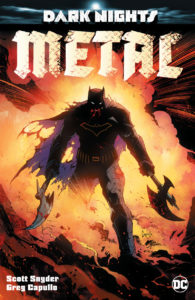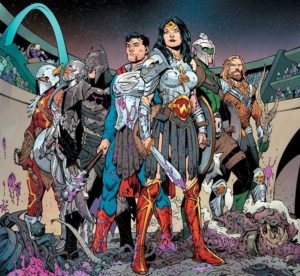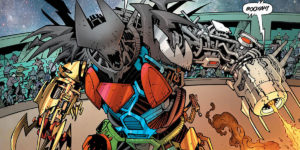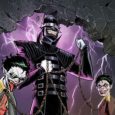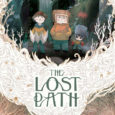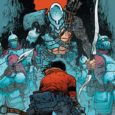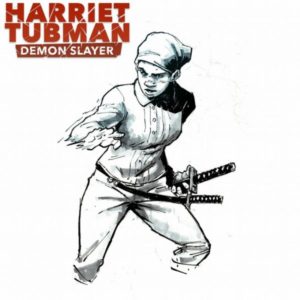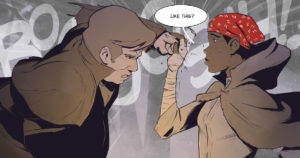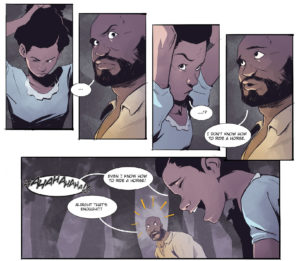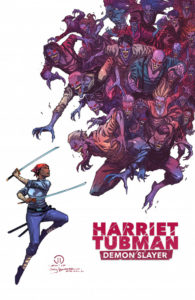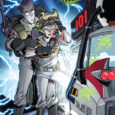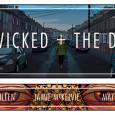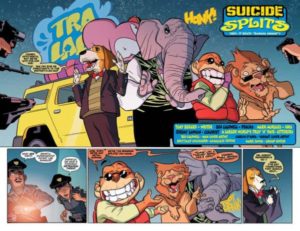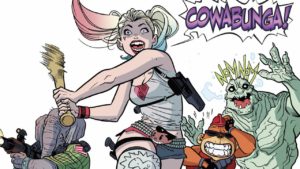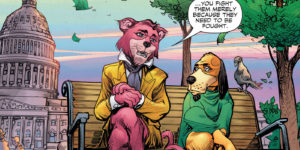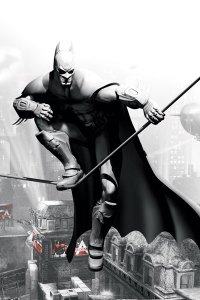For a few years back in the early 2010s horror mash up stories were all the rage. Take an innocuous but well known thing and mix it with a fantasy horror trope and a new hit was made. These were most evident through books like Pride and Prejudice and Zombies and Abraham Lincoln: Vampire Hunter and probably a few others not written by Seth Grahame-Smith. Though that genre has been dormant for a few years, it’s come back quite well with the recent release of Harriet Tubman: Demon Slayer.
Written by David Crownson, Harriet Tubman: Demon Slayer takes place (appropriately) in 1860, deep in the heart of America’s days of Slavery. It opens with a slave family, the Edgefields, as they escape their plantation in search of a life as free folk. When they run afoul of a trio of shady white men, the Edgefields stand their ground only to discover that these men aren’t exactly what they seem to be. Luckily, a mysterious stranger, the eponymous Harriet Tubman, shows up to save them.
One of the things I liked most about the book is the humor. Within the first couple of pages, Crownson makes a joke at the expense of one of his characters and it’s brilliant because it serves a higher purpose than a mere moment of levity. In addition to setting the tone for the book, that initial joke lets the audience know that despite the heady subject matter, they’re allowed to laugh at the story. This is a necessary cue for readers like me, a middle class white man, during the times that the N-word gets bandied around. That word would (rightfully so) make modern audiences uncomfortable but was necessary to tell a story that borrowed heavily from the time of slavery and Harriet Tubman’s real-life struggle. Crownson breaks the ice early to alleviate any possible squeamishness.
The art on the book is superb. Courtland Ellis’ art is smooth, his figures realistic and graceful. There are no overly muscular men rippling through torn shirts. His women aren’t bodaciously disproportioned, and in fact have noticeably different body types. Ellis uses subtle facial expressions on his characters to portray emotions and tip the readers off to what they’re thinking, but he’s then able to go all out during the funny moments. It can be a jarring juxtaposition at times but really ramps up the humor.
The art isn’t perfect, though. Most of the pages are beautiful, however, there’s some panel progression that feels off. Some of the character movement is choppy and stilted, which is detrimental in a book that relies heavily on fight scenes. Thankfully, it’s easy to overlook because there are so many other things to enjoy but hopefully it improves as the series progresses.
Ellis also shines in how he draws backgrounds, notably in the way he uses large brushstrokes to signify foliage. It’s drastically different from mainstream comics and I absolutely love it.
My biggest problem with the book is the dialogue. While most of the characters’ speech is smooth and energetic, the story is sprinkled with one-liners that just seem trite and unnecessary. It tended to be more good than bad, though.
I also wasn’t a fan of the localized dialect. This was probably included to show how different groups speak differently and was effective in establishing the world the story takes place in. I felt like it slowed down the reading experience, forcing me to puzzle out what the characters were saying. I understand that I’m splitting hairs here and maybe sound a little pedantic but this was definitely my take away from the reading experience.
Also, I need to point out the book’s poor punctuation. Normally I don’t even notice the lettering in comic books but the fact that this drew my attention means that it really stood out. Granted, some of the punctuation choices may have been stylistic but there are some instances that are just inconsistent, making the lettering come off as lazy or rushed. Again, I have hope that this will be remedied in future issues.
Despite its flaws, though, one thing that Crownson gets right is the mystery surrounding Harriet Tubman: Demon Slayer. His opening chapter focuses on establishing the characters. He doesn’t dive too far into why the vampires are chasing runaway slaves or even where Harriet comes from. We know nothing of her past, her upbringing, or how she knows how to fight. Crownson reveals just enough to whet my appetite but not too much that I lose interest and don’t return for the second issue.
Having purchased Harriet Tubman: Demon Slayer on a whim during Free Comic Book Day (it was funded through a successful Kickstarter), I have no idea how to get a physical copy of the book. However, you can buy it in digital on Comixology and Peep Game Comix. And I wholly recommend you pick it up. Not only is this book a fun read but it’s also an interesting take on the horror mash-up genre and the life of one of the most prolific American humanitarians.
Grade: B-
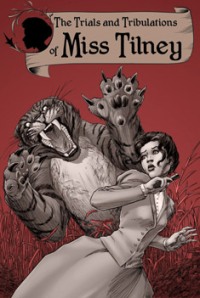 New from Dusk Comics is “The Trials and Tribulations of Miss Tilney”, a nod to the old British penny dreadful stories (early pulp fiction) that features the titular character as a columnist for the London Post, whose desire for a more juicy assignment lands her in the middle a conspiracy most foul.
New from Dusk Comics is “The Trials and Tribulations of Miss Tilney”, a nod to the old British penny dreadful stories (early pulp fiction) that features the titular character as a columnist for the London Post, whose desire for a more juicy assignment lands her in the middle a conspiracy most foul.
If you’re looking for a comic with high on the depth and light on the cheese, this isn’t for you. It’s a pulp story, and that’s what you should expect going in. In the first of three issues, Henrietta Tilney awarded an assignment to interview the accused murderers Lord Beowulf Harwood and Dr. Plum. The pair has been accused of hunting down and killing people a la The Most Dangerous Game. After visiting the prison and talking to the charming and scrappy Lord Harwood, Miss Tilney becomes convinced of the men’s innocence and offers to help them escape. She returns with Harwood and Plum to their estate in the hopes to further uncover the truth behind the murders and her new companions’ framing.
While neither the story nor the writing blew me away, I really appreciated the Gothic style and art. At the same time, I found the colors rather flat and uninteresting, though the last few panels were well done certainly peeked my interest (read it and you’ll see why) as the fate of Miss Tilney is left as a bloody cliffhanger. If you think pulp stories are silly or too cheesy…then this comic isn’t for you. However, if you are in to the genre, than the “The Trials and Tribulations of Miss Tilney” is a good salute to the old stories.
Batman: Arkham City picks up where the Batman: Arkham Asylum video game ends. Written by Paul Dini (of Batman: The Animated Series fame) and art by Carlos D’anda, the story begin right after you’ve finished Arkham Asylum and fought the Joker hyped up on Titan. The Joker is hauled back to the Asylum and he’s realized that Titan is slowly eating away his insides and knows there won’t be a next time to confront the Bat. The intense skill it takes to draw the Joker looking completely balls to wall crazy and then in the next frame, capture the Joker looking perfectly sane and capable of anything genuinely made me grin. He looks sickly but utterly capable of creating chaos as he begins cackling loud enough for poor locked up Harley to yearn for her puddin’.
Batman, meanwhile, is searching Gotham for a sister and brother pair high on Titan and wreaking havoc under the apparent orders from Two Face. We find out this isn’t the case once Bats infiltrates Two Face’s lair and instead it seems to be Hugo Strange who is pulling the strings. I’m definitely looking forward to the next issue in June, so check it out! I’d give it 3.5/4 stars!
Moon Knight
Moon Knight was something a little different for me since I didn’t read the original series back in 2006. The story is by Brian Michael Bendis (pretty much Marvel’s “golden boy”) and is a complete reboot of the character.
Jake starts this tale as a hot, popular television star, a show Wolverine labels as crap, and is celebrating at a party when the Avengers show up. He is forced to become Moon Knight again and stops a possible drug deal which is revealed to instead be a deal for….a dead Ultron? Artist Alex Maleev does a damn good job foreshadowing the end panel which shows Jake has clearly hallucinated everything we’ve just read and leaves you in a state of mindfuck.
You definitely don’t see that coming! I think it’s a good series for newcomers to start off with so I’d give Moon Knight # 1 2.75/4 stars.
I definitely enjoyed both but if you’re on a tight budget, I’d recommend picking up Batman: Arkham City #1. I think it’s going to have a better story, the pacing is neater and I ain’t gonna lie…I dig the Joker more!


